#d'ni
Explore tagged Tumblr posts
Text
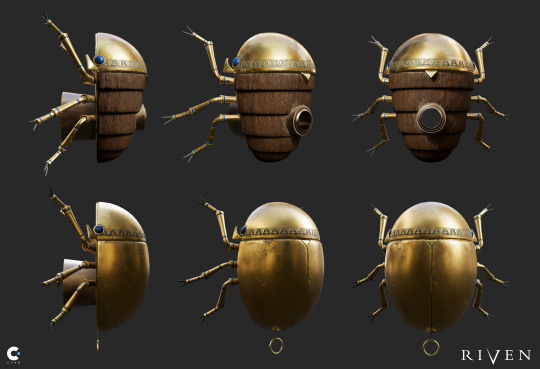




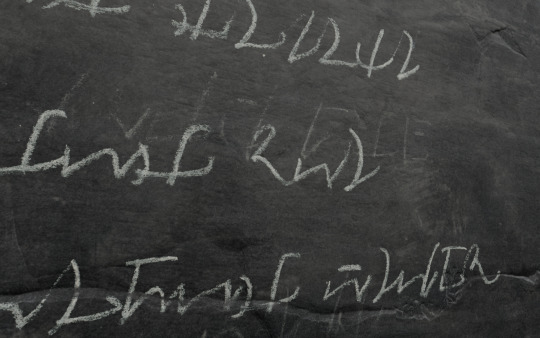





...Aaaaand some of my prop designs & models for Riven (2024).
So much of my own sensibility as a concept artist was inspired by Richard Vander Wende's work on the original Riven, so getting to work alongside him to re-create some of these objects (and design some new ones) was completely surreal. Meet your heroes!! Sometimes it works out because your brains work in the exact same way. 😎👍🏼
(Credits to my collaborators: Grave marker models by Lance VerMeer, rebel viewer handle design by Richard Vander Wende)
1K notes
·
View notes
Text





Mapping Riven (2024) - Temple Island
278 notes
·
View notes
Text

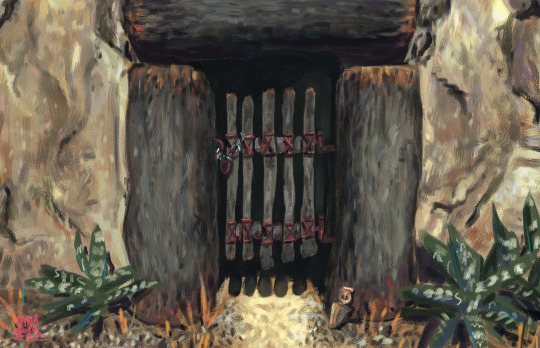

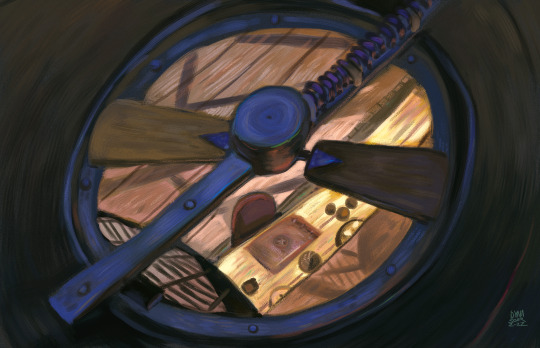
Riven paintings, 2022
#art#digital art#digital painting#painting#landscape#fantasy art#riven#myst#d'ni#dynasoar5#ssohardd#2022
832 notes
·
View notes
Text



125 notes
·
View notes
Text


couple of things i've been working on that i would fully make into poster-sized prints if i had access to the right kind of printer and poster paper 😅
99 notes
·
View notes
Text

A quick one for Mysterium's prompt Blooming. Desert flowers and the furtive roadrunner...
74 notes
·
View notes
Text







Riven 2024 demo
67 notes
·
View notes
Text
The story of Myst
Myst is a series of adventure games starting with 1993's Myst. The series consists of games and novels that are, in chronological order, Myst: the Book of Ti'ana, Myst: the Book of Atrus, Myst, Riven: the Sequel to Myst, Myst: the Book of D'ni, Myst IV: Revelations, Uru: Ages Beyond Myst (with expansion packs To D'ni and Path of the Shell), Myst V: End of Ages, and Myst Online: Uru Live. The series tells the story of the D'ni, a civilization possessing the power to travel to other worlds through writing special books, and of the family of Atrus, a D'ni man who helps rebuild the civilization. This post will be on the general backstory and worldbuilding of the series. I'll do a follow-up post showcasing some of the interesting worlds.

Worth noting is that the Myst 1-4 and the novels are presented as games fictionalizing real events in the setting of Uru. This was done to explain discrepancies between the lore on how writing and books work between the games and to state that the worlds visited in the earlier games are reduced considerably to fit on 1990s games.
In ancient times, there was a world called Garternay, which orbited a red star. It was home to a human-like people called the Ronay. The name Ronay means "people of the root" while Garternay means "root of the great tree", both of which reference the Ronay's view of the nature of reality, which followed the many worlds interpretation of quantum mechanics. Every possibility exists in some universe and every time a new event happens with multiple possible outcomes, the universe will branch into new universes, each of which will contain one possible outcome of the event. The Ronay viewed reality as the Great Tree of Possibilities, a metaphorical depiction of the branching nature of reality. They also believed the tree was planted by the god Yahvo, the Maker. What made the Ronay unique was they developed the ability to travel between the worlds, known as Ages, of the Great Tree. This was done through the craft known as the Art of Writing. By writing books describing Ages, the Ronay could travel to those ages.
The Art of Writing is central to the Myst series. It must be done with books made of a special paper, using special ink, and written in a special language. There are two types of books: descriptive books and linking books. Each age only has 1 descriptive books and an unlimited number of linking books. The descriptive book must be written first and describes the Age the writer desires to reach in extensive detail. Care must be taken to not write contradictory elements into the book, as they can lead to unstable and self-destructive Ages. Once the book is written, it will connect to an Age that most closely matches the written description. Even if two descriptive books are written that are exact copies of each other, they will not connect to the same Age, but to two separate but seemingly identical Ages. If a descriptive book is destroyed the link to its described Age is permanently lost. It is important to remember that writing descriptive books does not create Ages, it just links to Ages that already exist. The act of traveling between Ages is called linking. Every book contains a linking panel which is an image of the Age it links to. Touching this panel causes the person who did it to vanish and reappear in the other Age. There is a void between the ages that you momentarily inhabit while linking and appears as nothing but blackness (in real life, this is the games' loading screen). Once a descriptive book is written, additional linking books can be written that link to the same age. These books are smaller and refer to key passages of text in the descriptive book to make their link. If a linking book is written in the age it links to, it will link to the spot it is completed in. Otherwise, it will link to the same location as the descriptive book. It is not possible to link to the age you are currently in, but you can link somewhere else and then link back to a different location as long as you have access to the appropriate books. When linking, the book you use stays behind. When linking to a new age, always bring along a book back home or you will be trapped. Once a descriptive book is written, it can be modified, which can actually alter the age it links to. These changes must be subtle and not contradict earlier passages or the link will swap to a new age that fits the description better. If a descriptive book is destroyed, all its associated linking books will also cease to function. Sufficient damage to an age can also cause its books to stop functioning.

The Ronay initially believed they were linking to existing ages when they wrote their books, but eventually, a new belief took hold that they were actually gods creating worlds. This led the Ronay to pride and decadence and they began abusing the people in their Ages. Eventually, Ronay scientists realized that their sun was dying and Garternay would soon become uninhabitable. The majority of the Ronay chose to move to a paradise world named Terahnee, but some splinter groups moved to other Ages instead. Once of these splinter groups was led by a man named Ri'neref, who still believed in the old ways and sought to lead his people to a world of hardship to keep them humble. He wrote an age called D'ni ("new beginning") that was a great underground cavern centered around a lake. The lake was inhabited by bioluminescent algae which would glow orange on and off in a 30-hour cycle, mimicking day and night. Life there would be hard and the D'ni people would need to rely on other Ages to grow their food, which Ri'neref hoped would keep them humble. While the D'ni connected their cavern to the surface using fans to bring in fresh air, they never traveled to the surface and never knew if there were people living up there or not. In fact, D'ni was located on Earth, in a cavern beneath the desert in what would eventually become the American state of New Mexico.
At some point in their history, the D'ni encountered a species they called Bahro ("the least"). The Bahro had natural abilities to link to other Ages as well as abilities the D'ni did not, such as linking through time, linking between spots on the same age, and altering Ages in bizarre ways. Through methods that have been lost to history, the D'ni used a golden tablet to enslave the Bahro, using their abilities to enhance the Art, though it appears that the majority of the D'ni people did not know of the existence of the Bahro and slavery remained illegal throughout most of D'ni history. For millennia, the Bahro suffered at the hands of the D'ni.

Eventually, D'ni did begin to undergo a similar rise in pride that the Ronay did, though they never did reach the same levels of depravity as the Ronay. D'ni started out as a kingdom, though eventually the monarchy was dissolved and a system of guilds took over governance. The D'ni gradually began to abuse the Art and the people of the Ages they wrote. Eventually, a project was began to contact the surface. A great shaft would be drilled leading to the surface, but bears of an invasion by surface people (sparked by a war the D'ni had with the inhabitants of one Age) led to the project being cancelled when it was almost complete. However, the shaft had drilled high enough to connect with underground tunnels and lava tubes that led to the surface and they were eventually found.
In the early 1700s, a girl named Anna, the daughter of a trader, became lost in the lava tubes and eventually found her way to the great shaft. Following it downward, she was discovered by the D'ni and imprisoned while the council of guilds, driven by fear of outsiders, decided what to do with her. She was taken in by a man named Aitrus, guildmaster of the guild of surveyors and one of the main backers of the great shaft project. The two bonded over their shared curiosity and love of learning. Aitrus taught Anna the D'ni language and gave her a D'ni name, Ti'ana, meaning "dreamer". He was able to secure her release, though the guild council decided she would not permitted to return to the surface. Aitrus and Ti'ana eventually fell in love and married each other, a move that caused controversy in the more conservative citizens of D'ni. One of these citizens was Veovis, a friend of Aitrus who gradually grew more and more resentful of Ti'ana's growing influence on D'ni politics. Veovis befriended A'gaeris, a fanatical D'ni supremacist who believed that Ti'ana's presence had polluted D'ni purity. The last straw for them was the birth of Aitrus and Ti'ana's son Gehn and his admittance to the guild of writers, the guild responsible for writing descriptive and linking books. They launched a terrorist attack, using the cavern's ventilation system to spread a plague throughout D'ni. The majority of the D'ni died that night, with survivors fleeing to various other Ages. Ti'ana and Gehn escaped to the surface while Aitrus died to keep Veovis from killing them. The two settled in a small rift in the ground called the cleft.
Gehn grew up resenting Ti'ana, blaming her for the death of his father and destruction of D'ni. He would beet and marry a woman from a local tribe, but when she died giving birth to their son, Gehn left without a word and returned to D'ni, not even bothering to name his child. Ti'ana named her grandson Atrus, after her husband and raised him to be a curious child well-versed in the ways of science. When Atrus was 14, in the year 1773, Gehn returned and took his son into D'ni, intending to teach him the Art. Ti'ana believed her son would not allow Atrus to visit her as promised and secretly followed the two to the cavern. Gehn's education in the Art had barely begun when the fall happened. He came to fully believe the D'ni were gods creating world with their writing and he enslaved the people of his ages and forced them to worship him. His approach to writing was also fundamentally flawed. He merely copied phrases from other descriptive books with no care how they worked together, leading to unstable Ages. Atrus applied his scientific method to the Art and quickly became a better writer than Gehn, leading to tension between the two. After Gehn's attempted modifications to one of his Ages led to an environmental disaster and Gehn leaving the inhabitants to starve, he and Atrus got into a fight that led to Gehn imprisoning Atrus in a room in a D'ni mansion called K'veer, with the only way out being a descriptive book.
The book led to Gehn's fifth Age (Gehn never named his Ages, only numbering them), known to the natives as Riven. Atrus was saved from drowning by a native girl named Katran, through Atrus was unable to properly pronounce her name and called her Catherine, which eventually stuck. Atrus realized that Gehn planned to rebuild D'ni society (or rather his perverted version of it) in Riven, with Catherine having learned the Art from him, though like Atrus, Catherine's skill at the Art quickly surpassed Gehn's. Catherine also didn't have the scientific background that Atrus and Gehn did and she secretly wrote an Age called the Torus, which defied every scientific principle that Atrus knew, yet somehow remained stable. Atrus realized that Riven had the same problems with stability as all of Gehn's ages and he wanted to force Atrus to fix them. Atrus instead began to plan with Catherine and Catherine met and began scheming with Ti'ana. They came up with a plan to strand Gehn on Riven by destroying all the linking books out. Catherine and Ti'ana also worked together to write a new age, Myst, that they could all live on. Catherine also edited the Riven descriptive book. On the day the plan to trap Gehn was sprung, Catherine's changes took effect. The single island of Riven split into five and a great fissure opened on one of them. However, instead of leading to the underground, this fissure seemed to lead to space and was known as the star fissure. The star fissure appears to be an opening to the space between Ages. With the only linking book out of Riven being the Myst book, Catherine and Ti'ana escaped to Myst, leaving Atrus with Gehn. Cornered, Atrus leapt into the star fissure while linking to Myst, leaving the Myst book to fall into the fissure and trapping Gehn.

Now living on Myst, Atrus, Catherine, and Ti'ana lived together. Atrus and Catherine eventually married and had sons, the elder Sirrus and younger Achenar. Atrus also continued to hone his work with the Art. When Sirrus was 8, Ti'ana died in an accident on one of Catherine's ages. This broke the family. Atrus dealt with his grief by throwing himself into his work. His sons perceived this as rejection and grew resentful and bitter. Atrus did try to teach Sirrus and Achenar the Art, but stopped due to a perceived lack on interest on their part. Neither parent realized when Sirrus and Achenar began abusing Atrus's Ages, setting themselves up as gods to the natives and looting and plundering the worlds before slaughtering the inhabitants. They eventually planned to use a plan from one of Catherine's ages, Serenia, which had the ability to store memories, to steal Atrus's knowledge of the Art and then kill him. In preparation, they realized Atrus was onto their looting of his Ages and made a plan to imprison both parents. They tricked Catherine into returning to Riven and imprisoned Atrus by sending him to K'veer with a sabotaged Myst book that left him trapped. However, before they could finish their plan, the two had a falling out. They each used a linking book Atrus had told them never to use. They believed these books led to more ages to loot, but instead, Atrus had written them as traps for intruders to Myst. Each age, Haven and Spire, looked inhabited, but were in fact devoid of sapient life and of linking books back to Myst. This left any intruders imprisoned, but the ages had food and water to keep them alive. Thus, the sons were trapped, Sirrus in Spire and Achenar in Haven.
The Myst book that Atrus dropped into the star fissure continued to fall and eventually made its way back to Earth, in the desert above the D'ni cavern. In 1806, somebody found the book. This person, known only as the stranger, is the avatar for the player of the first 4 games and all details about them are left obscure so the player can imagine themself in the role. The stranger accidentally linked to Myst and, with no way home, explored the island and its linked Ages. Through exploring the ages, the stranger learned what Sirrus and Achenar had done and linked to K'veer with the supplies Atrus needed to fix his Myst book. Atrus had been working full time on the Riven descriptive book. The flaws in the age due to Gehn's poor writing had been compounded by Catherine's' changes and the Age was on the verge of collapse, kept stable only by Atrus's constant revisions.
Atrus chose to send the stranger through to Riven to rescue Catherine and imprison Gehn in a book that looked like a link back to D'ni, but actually led to a trap. On Riven, the stranger learned that a rebel group of Rivenese called the Moiety had begun opposing Gehn and worshiping Atrus and Catherine. They took Catherine in and she learned that Gehn was trying to make new books. He always wrote the ingredients for making books into his Ages, but he didn't know the actual recipes involved and was forced to experiment. Catherine retrieved one of his failed Descriptive books and made an invention to fix them, thus granting the Moiety access to their own age, Tay. However, Gehn eventually captured Catherine and imprisoned her on the smallest of the Riven islands. He also managed to make working books, though they needed a power source to function, and planned to evacuate Riven to a new age while he worked on a linking book to D'ni, fully willing to abandon the Rivenese to their deaths. The stranger managed to imprison Gehn in the fake linking book and freed Catherine, who evacuated the Rivenese to Tay. All that was left was the stranger alerting Atrus to come rescue Catherine. They did this by reopening the star fissure, the final straw that led to Riven collapsing. Atrus then came to take Catherine back to K'veer and allowed the stranger to fall into the star fissure. His reasoning was that if the Myst book reached the stranger's home through the fissure, the stranger would be returned home by falling into it.

After this, Atrus decided to embark on a restoration of D'ni, but he needed help as the only linking book he had to D'ni led to the sealed room in K'veer. He made a bargain with the natives of an age called Averone to get their help. Once they broke out of K'veer, Atrus started exploring D'ni linking books to look for survivors. After several failed attempts he did eventually find other D'ni survivors, who joined his efforts. With Atrus, the Averonese, and surviving D'ni working together, they made great strides on reconstructing the D'ni. That is until they found a linking book to Terahnee, the age most of the Ronay had fled to. The survivors made contact with the Ronay of Terahnee and found that the Age was a paradise, where nobody wanted for anything. The Ronay were happy to meet their relatives and invited the D'ni survivors to move to the age. Atrus and the survivors planned to accept the offer, but they then found that the utopia of Terahnee was in fact built on the backs of countless slaves. The Ronay considered themselves gods and wrote Ages full of people indoctrinated to slavery who would be worked to death for the Ronay's pleasure. Some members of the D'ni and Averonese joined a slave rebellion, but in the end, the Ronay were brought down by a plague. This disease was a simple stomach bug to the D'ni, but the paradise of Terahnee had no diseases and led to the Ronay having weakened immune systems, making the disease deadly to them. Atrus and the rebuilding effort left back to D'ni as the liberated slaves took control of Terahnee.
In the aftermath of the Terahnee incident, Atrus began to realize that at the end of its history, D'ni was starting to go down the same path the Ronay had. He decided that D'ni should not be rebuilt, it should instead stay in ruins as a memorial to the hubris, greed, and hate that had brought it down. The other D'ni agreed with his plan and Atrus set out to write a new Age for the D'ni to move to. It took him some time to get started, and in the meantime, he traveled to the surface of Earth and built a new home in a river near the cleft, a place he called Tomahna. At some point during this time, he reunited with the stranger and had a new child with Catherine, a daughter named Yeesha. To get inspiration for his new Age, Aturs visited a series of Ages he had written for Sirrus and Achenar. These Ages were intended to teach valuable lessons in how to Write a stable world. After finishing his new age, Releeshahn, Atrus invited the stranger to visit the age with him. However, when the stranger arrived in Tomahna, a mysterious person linked in, stole the Releeshahn descriptive book, and linked away after setting Tomahna on fire. The stranger followed him and found themself in the lesson ages. They discovered that the invader, Saavedro, was a native of the Age Narayan. Narayan was an age of balance, where the people had to live in harmony with nature to survive. Atrus intended it as the last of the lesson ages. It was one of the Ages that Sirrus and Achenar pillaged. They convinced the natives that Atrus had created them and made them suffer in toil, but they could free the Narayani. This led to civil war and when Saavedro tried to track down Sirrus and Achenar, they imprisoned him in the lesson ages. When Atrus visited the lesson ages, he had to leave behind a linking book to Tomahna, which Saavedro used to follow him. In secret, Saavedro learned of how Atrus was writing Releeshahn and misinterpreted this as Atrus being a god able to rewrite worlds. He set up a plan to steal the Releeshahn book to force Atrus to go through the lesson ages and show him the destruction Sirrus and Achenar put Narayan through, with the ultimate goal of forcing Atrus to rewrite Narayan. Even if it had been Atrus instead of the stranger who followed, this would be impossible as the Art cannot rewrite the past. The stranger was able to reveal to Saavedro that the Narayani were not dead as he thought and retrieved the Reeleshahn book in exchange for helping Saavedro reunite with his people

The incident with Saavedro made Atrus and Catherine wonder what had happened to their sons. They wanted to visit them and see if they had reformed, but could not do so without leaving a Tomahna book behind that the son could use to escape if not reformed. Catherine eventually wrote a cage into each prison age around the link-in spot. This way, the two could visit and speak with their sons, while being able to leave a linking book where the son could not reach it. After meeting their sons several times, Atruc invited the stranger back to Tomahna to get their opinion. However, during the meeting, someone set off an explosion and kidnapped Yeesha, forcing the stranger to investigate. Visiting the prison Ages of Haven and Spire revealed that the sons had somehow developed a means to breach the cages. Through investigating, the stranger realized that Achenar had truly reformed and regretted his former actions while Sirrus was still unrepentant. Sirus used natural resources in Spire to breach the cages and kidnap Yeesha, taking her to Serenia. He planned to use the unique properties of that age to replace Yeesha’ mind with his. Then, in Yeesha’s body, he would learn the Art from Atrus, allowing him to write his own Ages to rule. The stranger and Achenar stopped his plan, saving Yeesha, but costing both brothers their lives.

Yeesha grew up and learned the Art, using a unique style that combined Atrus’s adherence to science with Catherine’s more spiritual take. D’ni live vastly longer than humans and Rivenese, allowing Atrus and Yeesha to outlive Catherine and the stranger. Yeesha went to D’ni to learn in the ruins and there she discovered the Bahro and their slavery, which continued even after D’ni fell. She sought to free them and learned she had unusual abilities. Her linking books could break the normal rules and she developed the power to link without books. Her studies led her to a series of prophecies by a D’ni seer of a figure called the Grower, who would rebuild the Great Tree of Possibilities and was marked by powers including linking at will and linking through time. Yeesha came to believe she was the Grower and her duty was to free the Bahro.
Yeesha was not the only person who was exploring the D’ni cavern. In the 1980s, a group of human spelunkers discovered the D’ni cavern. They founded the D’ni Restoration Council (DRC), a group of historians, scientists, and archaeologists who wished to restore the cavern and its linked Ages for study and eventually open them to the public. Rebuilding went well initially, and the DRC published a series of games and novels presenting the public simplified takes on D’ni history and the events with Atrus and the stranger. Tensions began to rise in the DRC based on disagreements on how to proceed with the project. In addition, people from around the world were feeling drawn to the desert of New Mexico for reasons they couldn’t explain. One faction of the DRC started bringing people to the cavern while another wished to keep them out. These disagreements eventually led to the DRC disbanding and restoration being halted, but still more people came to the cavern. They had been brought to the cavern by Yeesha, who had set up a method to help free the Bahro. Each visitor would undergo a journey through five Ages Yeesha intended to teach lessons about the darkness within D’ni. Teledahn, an age used for making delicacies that hid an underground slave-trading ring. Gahreesen, an age used by the guild of maintainers as a fortress, to the point where guarding secrets is a goal in and of itself. Eder Gira and Eder Kemo, a pair of garden Ages whose native population was forced out to allow the D’ni to relax. And Kadish Tolesa, a vault made by a rich guildsman named Kadish to hide his treasure and wealth. By visiting the Ages, the explorers could retrieve pillars and move them into caves in the ceiling of the D’ni cavern. The pillars held parts of the “self” of a Bahro and moving all four to D’ni would free a single Bahro. However, this method was intolerably slow and Yeesha sought a better option.

Another discovery Yeesha made in D’ni was of Kadish, the guildsman who owned Kadish Tolesa. He was a writer who set himself up as the Grower, using his ingenious writing ability to replicate the feats the Grower was said to fulfill. This was all to create a following and hoard wealth. When D’ni fell, he fled to Kadish Tolesa and died alone in his vault. He considered dying with his treasure to be a good death, something that baffled Yeesha. Through studying his actions, Yeesha further reinforced her belief that she was the Grower.
At some point, Yeesha discovered the golden tablet that enslaved the Bahro. Attempting to use the tablet to free the Bahro, she went through a series of trials to claim it, trials which had been set up by an unknown party. She claimed the tablet, but her ambition went too far and in her pride, Yeesha lost access to the tablet. She considered herself a failure and fell into despair and bitterness. Eventually, another person was drawn to D’ni to take the challenge of the tablet. This was Dr. Watson, one of the leaders of the DRC. He was met by Yeesha and another D’ni named Esher. Esher also believed himself to be the Grower and had also taken the trial of the tablet and held it for a while, but was judged unworthy and lost it. He offered to help Dr. Watson through the trials. While visiting the Ages of the trials, Watson learned that Esher had fled the fall of D’ni to Noloben, home of the Bahro. He performed torturous experiments on the Bahro and learned some of their abilities. He considered the Bahro to be lesser beings and wished to command the tablet to use their power for his own purposes. Upon claiming the tablet, Esher and Yeesha both asked for it, but Watson instead dropped it and walked away. Whoever controls the tablet controls the destiny of the Bahro, and by dropping it, Watson allowed the Bahro to claim it, thus finally freeing them all. Yeesha was finally freed of her burden as the Grower and Esher was captured by the Bahro. Watson was taken to Releeshahn and met an elderly Atrus, who said that now that the D’ni’s greatest crime, the enslavement of the Bahro, was undone, the D’ni people could truly begin to heal.

Sometime after that, Watson returned to Earth and helped restart the DRC. Work once again began on restoring the cavern and visitors were allowed in to explore. During the events of the game Myst Online: Uru Live, there was a planned storyline following up on the events of Myst V involving a civil war between the newly-freed Bahro, one faction wishing to coexist with the humans and D’ni and the other angrily lashing out and attacking people in the cavern. However, the game was shut down before this storyline could be seen through.
#Myst#myst game#riven#riven: the sequel to myst#myst iii exile#myst iv revelations#myst v exile#uru#uru ages beyond myst#uru live#lore#worldbuilding#infodump#d'ni#atrus#yeesha#long post
7 notes
·
View notes
Text
The Basics of D'ni Grammar
(research by Richard Watson)
D'ni is not an Earth language, but because the D'ni are so similar to humans physically and mentally, their language has similarities to some of our native tongues.
D'ni is often compared with Hebrew, since the two languages have similar characters and sounds. But there are many differences, with the most obvious one being that D'ni is written left to right, unlike Hebrew.
The D'ni alphabet has 24 characters, but there more than 24 consonants. These are created by adding indicator marks to a letter. For instance, the character for a "v" sound is the same as the character for a "b," only the "b" has a dot over it. Generally, any consonant without a dot is a fricative, meaning it's produced by air passing continually between the tongue and lips. A consonant with a dot over it contains a stop, meaning that the air is cut off. in the case of a dotted "v," the air is stopped by the lips. By adding indicators to their vowels, D'ni's six vowel letters are expanded to eleven vowel sounds in their spoken language.
D'ni follows a familiar noun-verb structure. Adjectives follow the nouns they modify. Adverbs follow the verbs they modify. Quantifiers such as "very," "extremely," and "really," which add emphasis to phrases, are indicted by numbers from one to twenty-five. The higher the number, the stronger is the emphasis. For example, the phrase "I am a little tired" in D'ni becomes, "I am tired to two." "I am very tired" would be. "I am tired to twenty." To exaggerate something, the D'ni would use a number over twenty-five. "I am incredibly tired," in D'ni could be written or spoken as, "I am tired to thirty."
There are a number of important prefixes and suffixes in D'ni. Verbs use a suffix to indicate both number and person (this is similar to Spanish). For example, the D'ni word for eat is "rees," which is the form it takes when you say "I eat." The suffix "en" is added to indicate that he, she, or it eats, "rees-en." "They eat" uses the suffix "eet." "rees-eet." "We eat" uses "et," "rees-et." "You eat" (singular) uses "em," "rees-em," "You eat" (plural) uses "tee," "rees-tee." You can change this phrase to a command by adding the additional suffix, "ah." To order an individual to eat, you would say, "rees-em-ah!"
Verbs use a prefix to indicate the past, present, and future. To say that you have finished eating, the phrase is "ko-rees." To say that you are currently eating, the phrase is, "do-rees." To say that you will eat later, the phrase is "borrees." Other forms of the suffix are:
• kodo (past progressive): kodo-rees (I was eating)
• le (perfect): le-rees (I have eaten)
• kol (past perfect): kol-rees (I had eaten)
• bodo (future progressive); bodo rees (I will be eating)
• boko (future perfect): boko-rees (I will have eaten)
• bodol (future perfect progressive):
bodol-rees (I will have been eating)
Other common prefixes are "re" for "the." The D'ni word for "book" is "kor," so to indicate "the book," the phrase is "re-kor." The word "and" is "ga," so to indicate "and the book, you would say "ga-re-kor." Suffixes can indicate ideas such as plural and possession. To make a noun plural, add "tee" to the end.
The word for "books" is "kor-tee." To indicate possession, add the suffix "akh," which roughly corresponds to "of." The phrase "Gehn's book," in D'ni is structured, "book of Gehn," and is written, "kor-okh Gehn." An adjective, such as "garo" ("mighty"), can be changed to a noun with the suffix "th," as in "Garoth" (Mighty One). You can change the same adjective into an adverb with the suffix "sh," "garosh," as in "mightily." There is also a special set of characters called the "Garo-hevtee," "Great Words." These symbolize important ideas of groups of words.
From " From Myst to Riven: The Creations and Inspirations" (1997)
41 notes
·
View notes
Text
D'ni callout posts for people who write problematic Ages
4 notes
·
View notes
Text

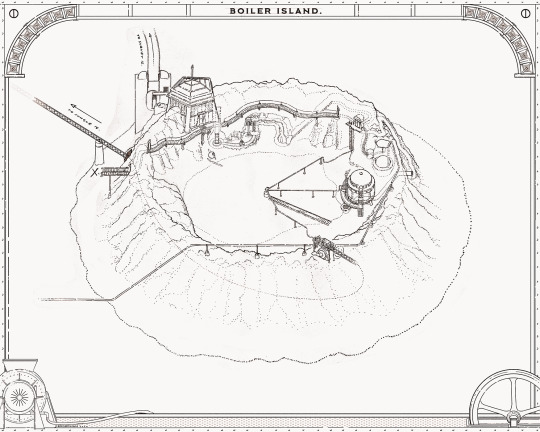
Mapping Riven (2024) - Boiler Island (spoilers)
#riven#riven remake#myst#maps#architecture#illustration#technical illustration#micron pens#d'ni#cyan
136 notes
·
View notes
Text
Holy shit, actual Riven content in the Riven tag.
4 notes
·
View notes
Text
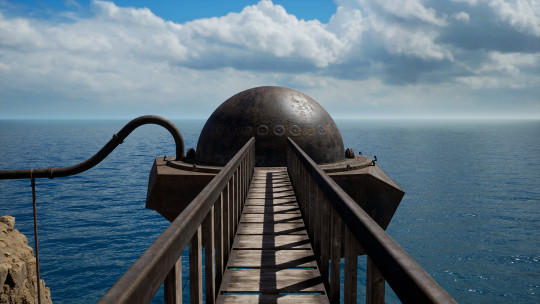

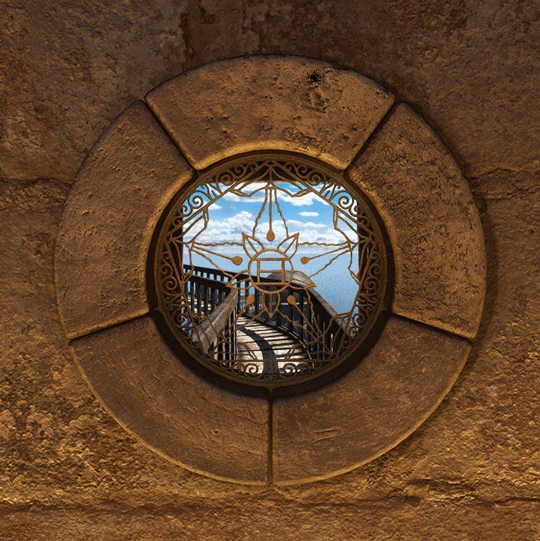
82 notes
·
View notes
Text
Why is it that, every so often, when my mind wanders I remember the opening scene of Myst?
That scene of a marvellous special book slowly falling through the star fissure into that glittering starry expanse has embeded itself deep into my brain. I just wish to know, why?
2 notes
·
View notes
Text

As per previous puzzleposting,
127 notes
·
View notes